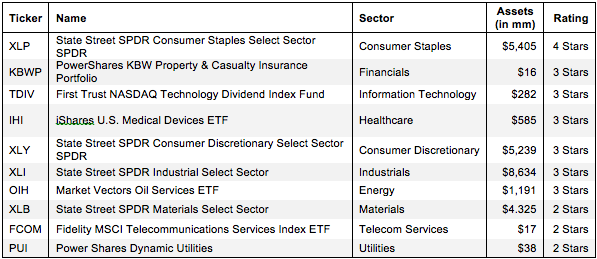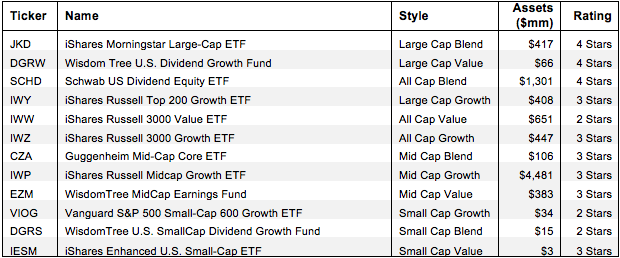How To Find The Best ETFs
Post on: 2 Июнь, 2015 No Comment

When selecting an exchange-traded fund, it might be helpful to imagine you’re speed dating. You want to ask a few key questions and do some research to find your perfect match. For example, look at an ETF’s price and tracking accuracy before you marry it. Also remember there are many, many fish in the ETF sea.
Certainly ETF growth has been strong. As of this September, ETF assets totaled $698 billion, an 18.7% increase from the year before. The number of ETFs has also grown in that time from 720 to 785.
Before you invest, think about why you want an ETF, says Matt Samelson, founder of Woodbine Associates. Likely the most obvious reason is because exchange-traded funds offer investors the opportunity to buy and sell indexes as they would stocks. They also offer retail-level investors the chance to own indexes and properties they would be hard-pressed to buy any other way; including commodities, currencies and individual nations.
Follow Intelligent Investing on Twitter.
Sign up for the Daily Intelligent Investing Newsletter.
Woodbine also gives a few other reasons for why ETFs are attractive. One reason is because, unlike mutual funds, they can be shorted. Also, many investment advisers have touted ETFs as a way of making fewer decisions and doing less research because you’re buying a basket of securities rather than just one stock. There’s less risk that one bad apple will spoil the bunch.
ETFs–which can be categorized by capitalization, sector and other categories–still require research because you have to follow the industry of the ETF you pick. For example, if you purchase the iShares Dow Jones U.S. Energy Sector Index Fund. you’re going to have to follow the energy sector and other elements that relate to this sector, such as the weather. If you purchase this ETF, monitor stocks like Exxon Mobil. Chevron and Schlumberger. which are IYE’s top three holdings.
Shannon Zimmerman, lead adviser of Duke Street, adds that ETFs can be a good way to diversify your portfolio. ETFs should be purchased alongside single stocks, Zimmerman advises, adding that the more ETFs you buy, the more that you can concentrate on having a few, strong stock picks.
When investigating in ETFs, look at expense ratios–the cheaper the better. Vanguard has been the low cost leader, Zimmerman says. Investors should also look at a fund’s tracking error. To do this, take your ETF’s net asset value, compare it to its benchmark, and if it’s significantly above the expense ratio, look into why that is. For example, the SPDR S&P 500 has a 0.33 net asset value and it trails the S&P 500 by 17 basis points, says Zimmerman. The fund’s expense ratio is nine basis points, which bears looking into.
There can be reasons why an ETF would fall into this scenario, Zimmerman says. Some ETFs don’t completely replicate the index that they’re based on, but instead sample it. Overall, an ETF that has a difference between its net asset value and benchmark compared to its expense ratio of 25 to 30 basis points is worthy of caution.
Lately, bond ETFs have received a lot of attention for tracking widely from the indexes they are supposed to follow. This is troubling because fixed-income ETFs are showing feverish growth: Currently they total $95.1 billion, almost double from the year prior. Should you worry?
The Motley Fool’s Zimmerman doesn’t think so. In fact, he has invested in some bond ETFs, which because of the market downturn have given equity-like returns despite being in the fixed-income category. For example, the iShares Barclays Aggregate Bond Fund’s price has risen from $96.61 on Oct. 7, 2008, to $104.54 on Oct. 6, 2009, up 7.6%.

Zimmerman also recommends looking for ETFs with higher trading volume, because thinly traded ETFs will have a very wide bid/ask spread. “ETFs are a nice way to hedge without taking a capital gains hit,” Zimmerman says.
Tom Lydon, president of Global Trends Investments, says good ETFs have a reasonable expense ratio, a well-diversified underlying index and underlying stocks with lots of liquidity. He cites the iShares Russell Microcap Index (IWC) as a prime example of a good ETF for the above reasons. Its top three holdings are Georgia Gulf Corp. Schweitzer-Maudit International and Veeco Instruments .
By contrast, a bad ETF has a higher expense ratio, a few companies in the underlying index which dominate the weighting, and represents a less liquid area of the market, such as a single country ETF or a thinly traded sector. An example of this, he says, is the Global X/InterBolsa FTSE Colombia 20 ETF .
John Osbon, founder of Osbon Capital Management, advises retail investors to also look at the strength of the entity sponsoring the ETF, such as iShares or Vanguard.
Get Intelligent Investing On Your iPhone.
See More Intelligent Investing Features.














